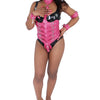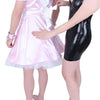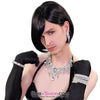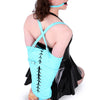Guide to Corsets for Crossdressing & More
Ohh the world of corsets…it is as big as an oyster…because the world is our oyster (get it?...ehh, ok, I’ll admit I’m not even sure where I was going with that one). The point here is: the world of corsets has a lot of seams terms and definitions completely engrained with the lifestyle of wearing corsets. And if you are going to be (or are!) someone who will wear corsets, you will need to be familiar with the terms.
Whether you are a man who cross dresses, or even just someone who wants to begin with waist training practices, you may want to continue reading this lil’ guide about corsets. It is simpler than it sounds but more complicated than you think…insert mysterious sound here*
One phrase you will read and listen a lot will be natural waistline. This is nothing more that the part of your body where your waist is at its narrower. Generally this point is located at about 2 inches above the navel in women; in men, is located near the navel if not bellow.
For natural waistline measurements, you want take off 4 inches of the size you want. For instance, if the natural waistline is 34 inches, you want to get a 30-inch corset.
When it comes to corsets, back lacing is something mentioned quite a lot. This refers to the cords or laces located at the back of the garments. They are meant to adjust how tight the corset is; the pieces that are meant to be worn as a decorative piece usually have ribbon or laces at the back.
The boning of a corset is the part intermingled with the panels that make the piece sturdy and nimble. The name probably refers to the old antique corsets; back then the corsets were made out of actual animal bones (I know, vegetarians/vegans look away) but fear not, in present time they are usually made out of steel or are simply a flat design. Keep in mind that the decorative corsets use plastic boning, don’t try to tighten those because you will break them.
On the other hand, we have the busk. This is the part where the corset gets fastened and it is usually located in the front part of the piece. Now, there are several variations; commonly the fastening has little clips, but some models have zippers too. When you are looking for a corset, one of the main things you want to make sure it’s the busk is strong and sturdy. This part of the corset takes a lot of pressure and you don’t want for it to comprise the overall cinching that takes place when you tight up the garment.
And this brings me to the length. Cincher is a definition used for the under bust corsets that measure 10 inches or less. They are called like that because they only cinch the waist; given they are short, they won’t be able to do anything about the belly. As they are shorter, the busk has fewer fasteners, generally only about 4.
Another important component of the corset is the modesty panel. Although the name may sound weird, it is nothing more than a piece of fabric that is located in the eyelets at the back. The idea is for it to create a kind of coverage between the laces or chords and the skin; for instance, sweat can damage the laces, so you don’t want direct contact. Besides, the laces can dig on the skin and well, that can definitely be painful (and not the good kind of pain wink*).
Now, you should know that not every piece has a modesty panel. This is merely because sometimes, that extra piece of fabric can bunch a little, interfering with the lacing and the cinching; it will really depend on the model you choose, and if you really feel like you need a corset with a panel or you can go without one.







